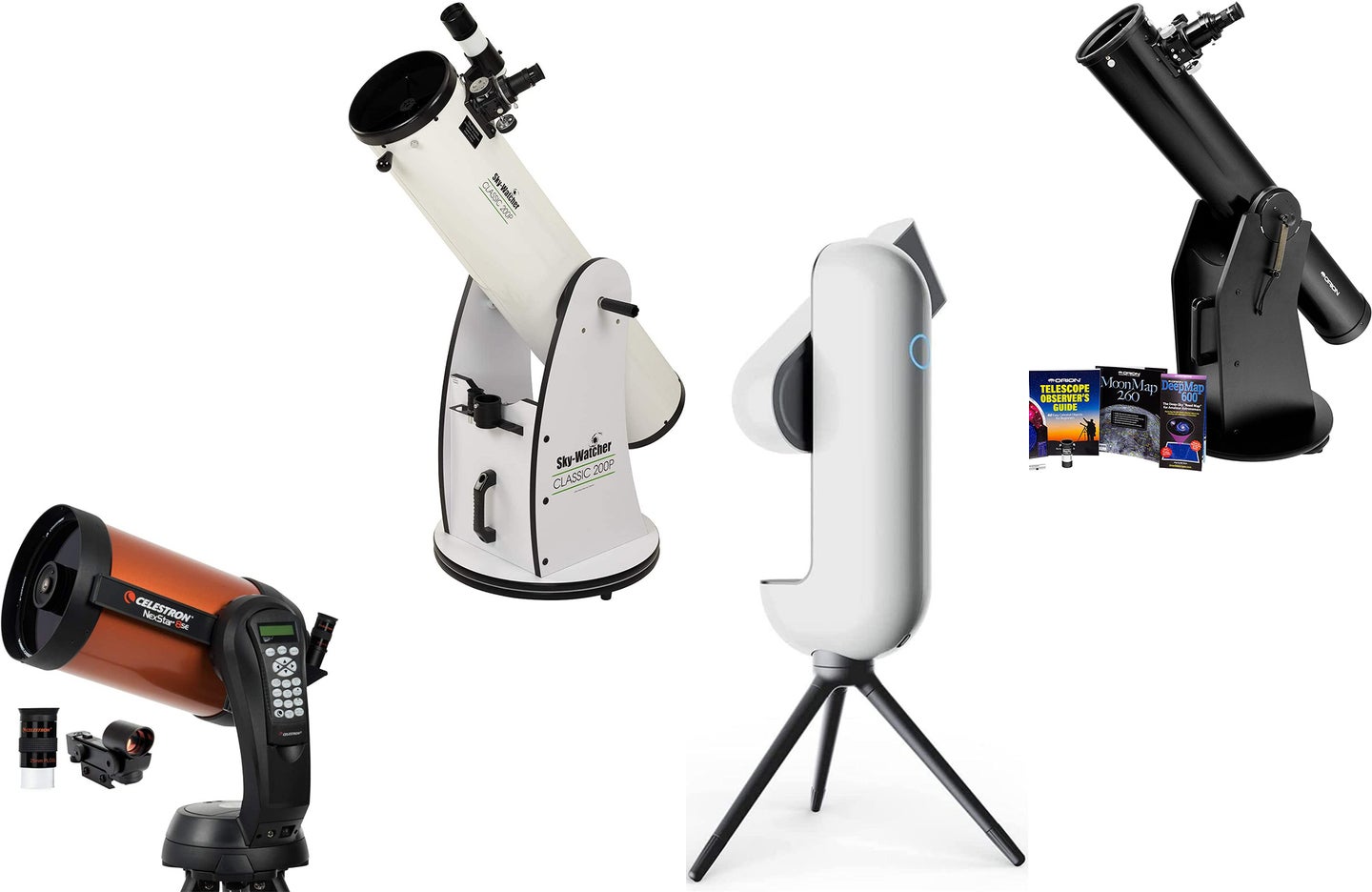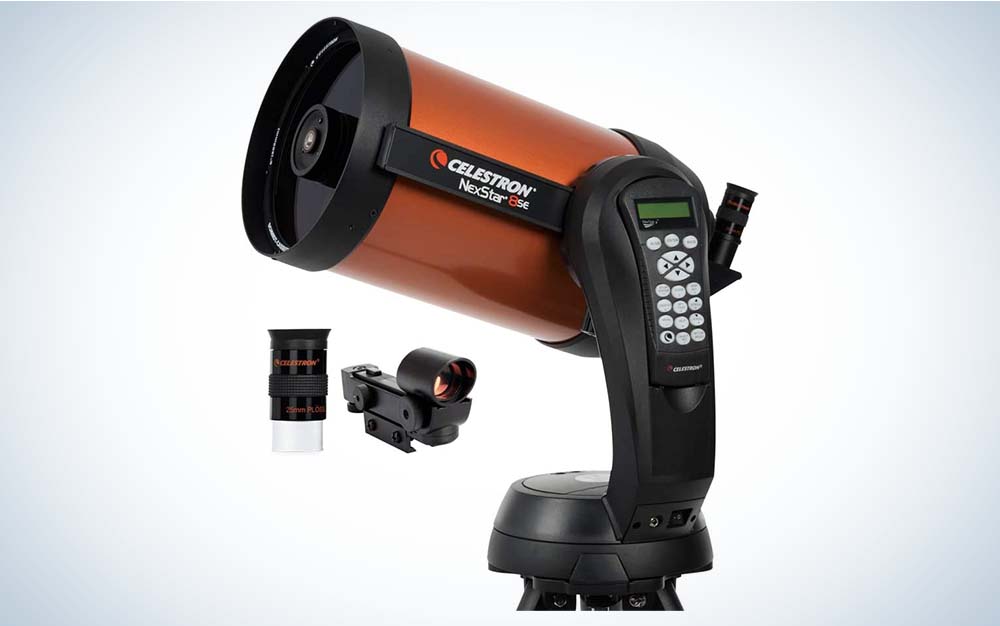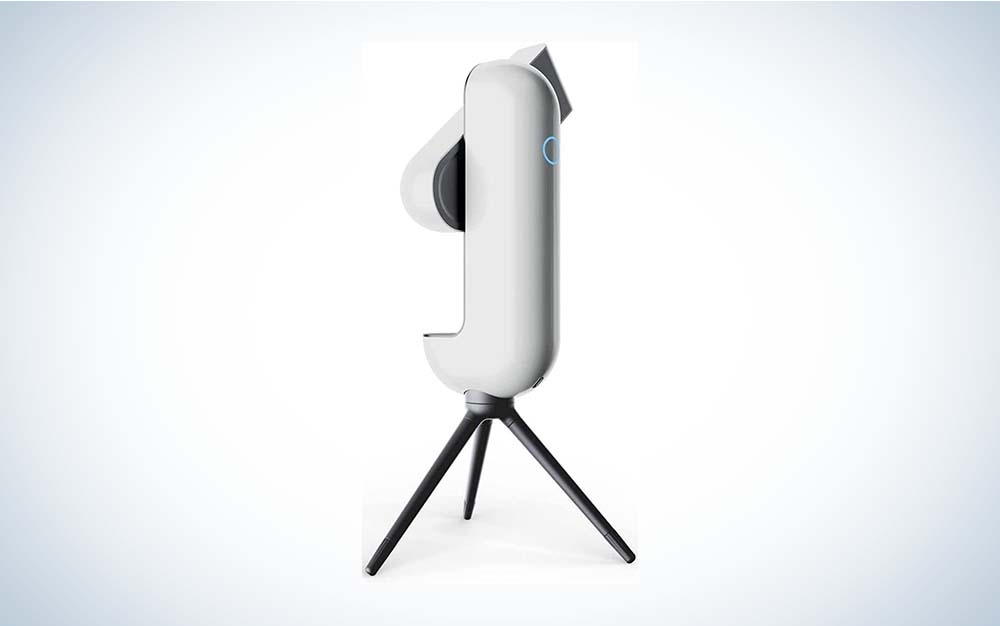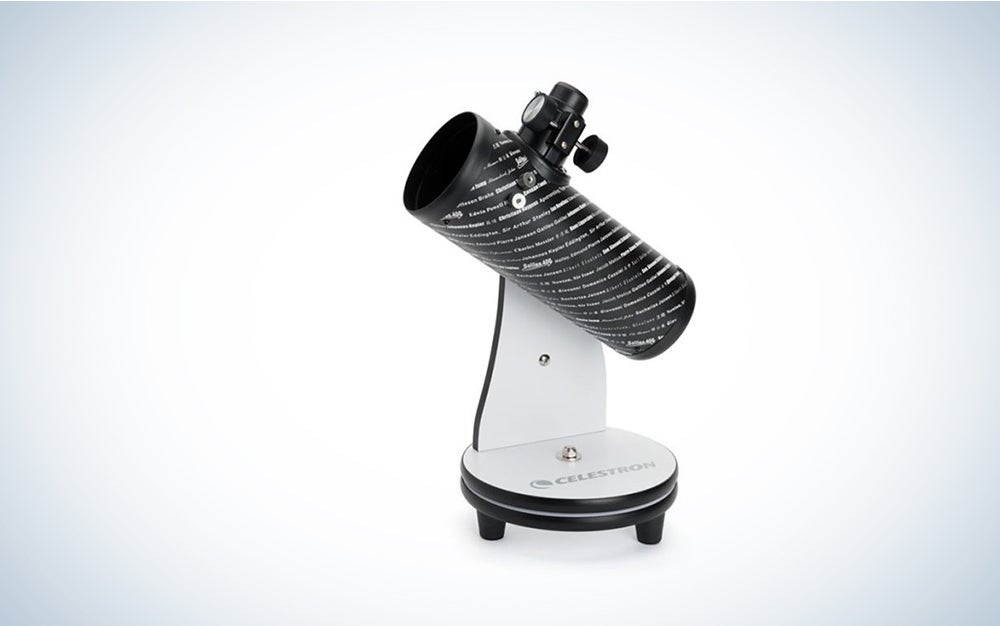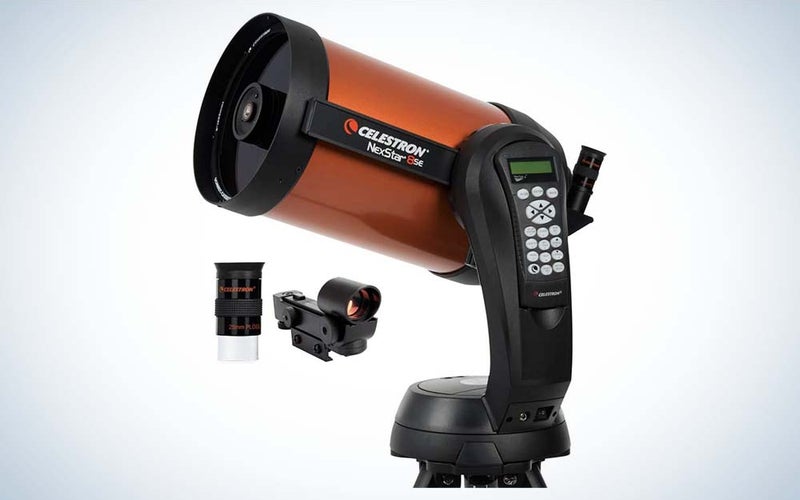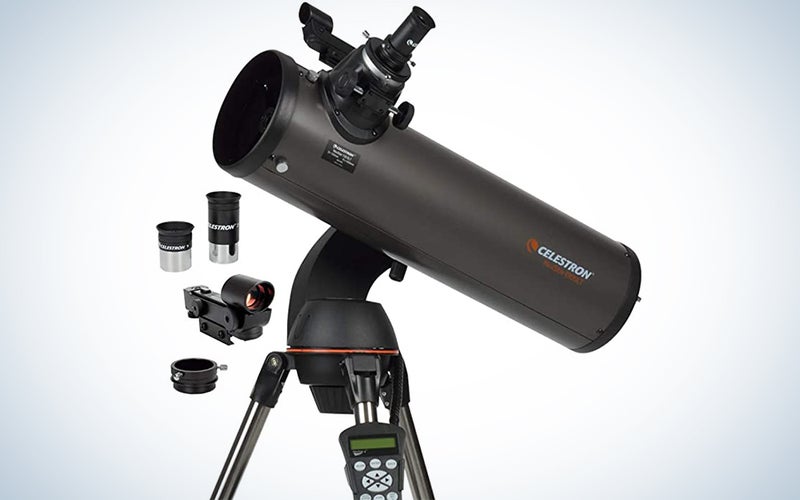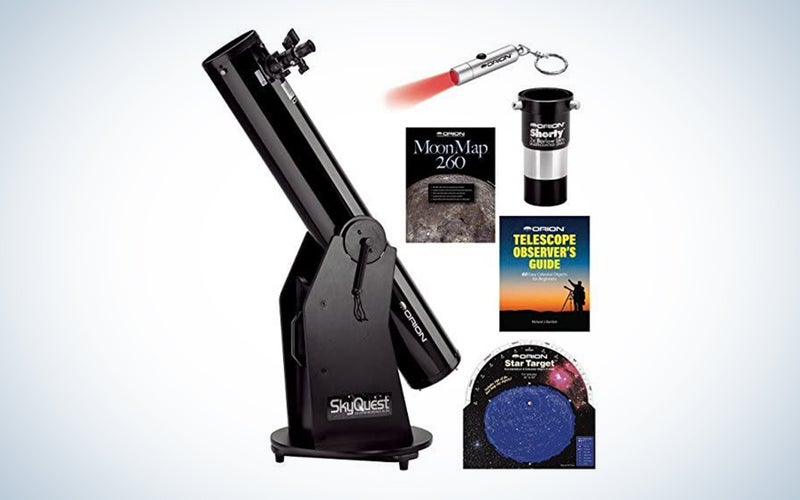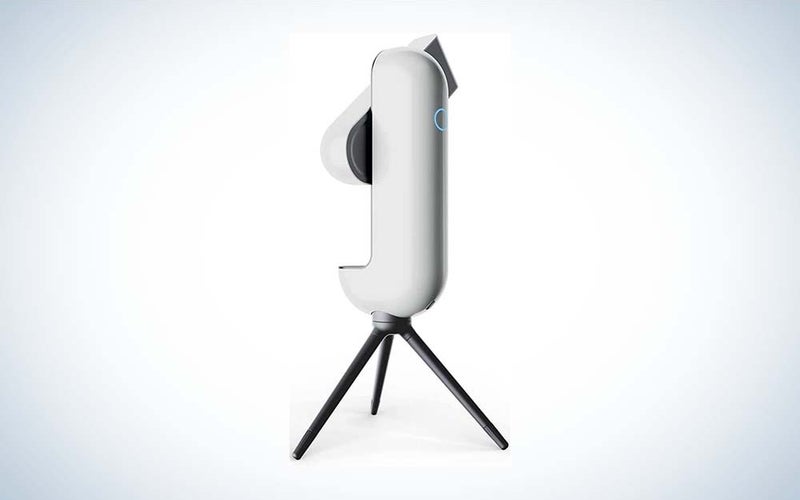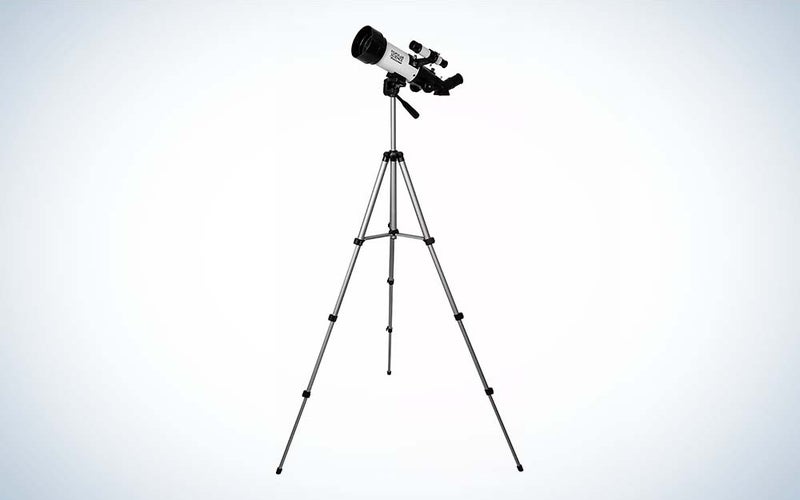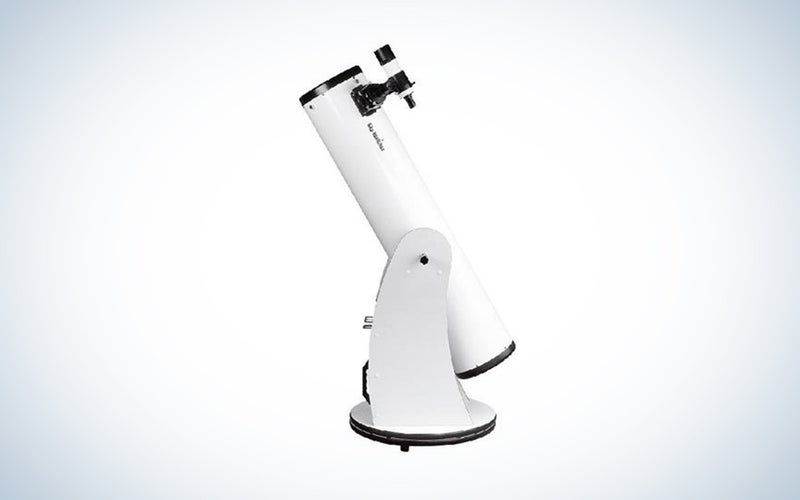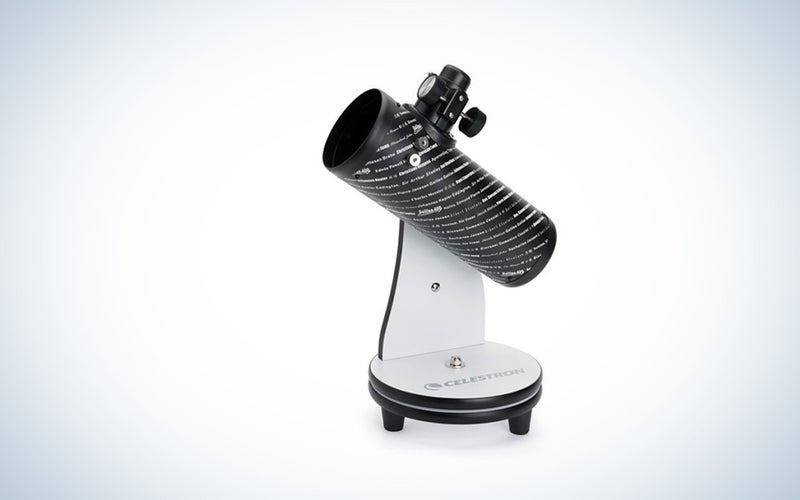We may earn revenue from the products available on this page and participate in affiliate programs. Learn more ›
There’s always something new to see in space—and a telescope can help you make the most of the experience. Viewing Saturn’s rings or the moon’s surface doesn’t require much work, but the optical power of a good telescope can allow you to get a much better picture of the galaxy. Here are our recommendations for the best telescopes for everyone, from beginning stargazers to longtime astronomers and photographers of the night sky.
- Best overall: Celestron – NexStar 8SE Telescope
- Best smart: Celestron NexStar 130
- Best for beginners: Orion SkyQuest XT6 Classic Dobsonian Telescope Kit
- Best for astrophotography: Vaonis Vespera
- Best for travel: Popular Science by Celestron Travel Scope 70 Portable Telescope
- Best tabletop: Sky-Watcher Classic Dobsonian 8-Inch
- Best budget: Celestron FirstScope Telescope and FirstScope Accessory Kit
How we chose the best telescopes
We started with the experts to compile our recommendations for the best telescopes. According to Bart Fried, executive vice president of the Amateur Astronomers Association of New York, you don’t need a pair of binoculars or a telescope to view Mercury, Venus, Mars, Jupiter, and Saturn in the sky. “The ones that were known to the ancients are visible naked eye,” Fried says. “So if they know where to look, they can watch the planets and see them move in relation to the background stars over time.”
But you’ll want to use a telescope to see more detailed images of the planets, such as Saturn’s rings or Jupiter’s moons. We looked to trusted brands such as Celestron and Sky-Watcher and newer brands like Vaonis in compiling our recommendations for telescopes to see planets. We also included options for more experienced astronomers who are looking for high-level optics definition and smart features.
The best telescopes: Reviews & Recommendations
Purchasing a telescope can be an intimidating experience if you’re just getting started with astronomy. In this guide, we’ve broken down the important features to look for and made recommendations for a range of skill levels.
Best overall: Celestron – NexStar 8SE Telescope
Celestron
Specs
- Type of telescope: Catadioptric
- Aperture: 203mm (8 inches)
- Magnification: 81x
- Mount: Altazimuth
Pros
- Tried-and-true option
- Wide aperture to see more
- Provides guide to locate more than 40,000 celestial objects
Cons
- Expensive
- No connectivity
This classic design from trusted maker Celestron dates back to the 1970s. It’s easy enough for beginners to use, while providing the optical power that experienced users are looking for. Its large, 8-inch aperture helps viewers see the moon and planets as well as deep sky objects. The NexStar 8SE is also designed with an automated mount to locate more than 40,000 objects in the night sky. The kit also comes with a tripod that’s easy to set up, making this telescope easy to take with you.
Best smart: Celestron NexStar 130
Specs
- Type of telescope: Newtonian reflector
- Aperture: 130mm (5.1 inches)
- Magnification: Eyepiece 1: 26x; eyepiece 2: 72x
- Mount: Alt-azimuth
Pros
- Works with Wi-Fi
- Shows great detail
- Comes with database and interactive software
Cons
- Some users reported issues with calibration
For an expansive view of the cosmos, this computerized telescope pick features a Newtonian reflector optical design with a 130mm-aperture that lets you see the clouds around Jupiter and the moon’s surface in great detail. This smart telescope also comes with a database that allows you to track 40,000 galaxies, stars, and more; is WiFi-compatible; and comes with interactive sky-simulation software.
Best for beginners: Orion SkyQuest XT6 Classic Dobsonian Telescope Kit
Specs
- Type of telescope: Dobsonian
- Aperture: 150mm
- Magnification: 48x
- Mount: Tabletop
Pros
- Easy to set up
- Comes with stargazer guide and moon map
- Features smartphone adapter
Cons
- Some users report that finder doesn’t work well
This telescope for beginners offers a stable mount, a 1.25-inch 25mm eyepiece, and a red dot sight to help accurately view the planets. The kit comes with a stargazer guide and moon map for amateurs to easily make new discoveries, plus a mini flashlight, and a smartphone adapter so you can take photos and videos to record what you’re seeing in the night sky with this beginner telescope. For more options, check out our guide to the best telescopes for kids.
Best for astrophotography: Vaonis Vespera
Vespera
Specs
- Type of telescope: Telescope and camera in one
- Aperture: 50mm
- Magnification: 33x
- Mount: Alt-azimuth
Pros
- Can take beautiful photos of the galaxy
- Sleek design
- Uses GPS, star patterns, and astrometry to locate celestial objects
Cons
- Expensive
- Small aperture
The Vaonis Vespera Telescope is an entirely new kind of telescope. Billed as “the world’s lightest observation station,” this easy-to-use, 11-pound device is a telescope and camera in one. Designed with an ultra-sensitive Sony CMOS sensor built-in, the Vespera uses your phone’s GPS, star patterns, and astrometry to calibrate and find celestial objects in the night sky.
The associated app provides access to a catalog of more than 300 objects. This telescope for adults updates in real-time and provides personalized recommendations based on your location and interests. Photographers will delight in the 50mm quadruplet lens made with lanthanum glass, which allows for stunning photography. This astrophotography telescope also makes capturing images easier with an autofocus mode. And at 15.5 pounds, the Vespera is easy to transport. That said, all these features do come at a premium price, however.
Best for travel: Popular Science by Celestron Travel Scope 70 Portable Telescope
Celestron
EDITOR’S NOTE: Popular Science has teamed up with Celestron on a line of products. The decision to include this model in our recommendations was made by our reviewer independently of that relationship, but we do earn a commission on its sales—all of which helps power Popular Science.
Specs
- Type of telescope: Refractor
- Aperture: 70mm
- Magnification: Eyepiece 1: 20x; eyepiece 2: 40x
- Mount: Alt-azimuth
Pros
- Features a comprehensive kit with a moon filter
- Bluetooth connection and smartphone adapter allow for sharing photos and video
- Comes with a travel backpack for easy portability
Cons
- Materials are less substantial than for some models
Looking for a telescope kit that’s easy to set up and take on the go? The Popular Science by Celestron Travel Scope Portable Telescope is a great option. The kit has a 70mm refractor telescope, tripod, two eyepieces (20mm and 10mm), a 3x Barlow lens to increase magnification, and a moon filter to get you started. The finderscope and 45-inch erect image diagonal will help you locate objects in the night sky. This telescope also features a smartphone adapter and can connect via Bluetooth with a shutter release so you can capture images of the moon, stars, and beyond. The telescope also works during the day to spot birds and other terrestrial sights. And at just 3.3 pounds, with an included travel case, this telescope is designed for portability.
Best tabletop: Sky-Watcher Classic Dobsonian 8-Inch
Specs
- Type of telescope: Dobsonian reflector
- Aperture: 203mm (8 inches)
- Magnification: Can use range of eyepieces
- Mount: Alt-azimuth
Pros
- Easy to use
- Wide aperture
- Comes with a finderscope
Cons
- Requires stable, flat surface to use
This telescope from Sky-Watcher comes with a 2-inch focuser and 1.25-inch adapter that allows viewers to choose between eyepiece sizes. The four-arm secondary mirror bracket helps reduce light loss and diffraction spikes. Plus, this model includes a 9×50 finderscope and a tension control handle.
Best budget: Celestron FirstScope Telescope and FirstScope Accessory Kit
Specs
- Type of telescope: Newtonian reflector
- Aperture: 76mm (2.99 inches)
- Magnification: Eyepiece 1: 24x; eyepiece 2: 50x
- Mount: Alt-azimuth
Pros
- Budget-friendly
- Comes with finderscope
- Kit comes with educational materials
Cons
- Small aperture
- No connectivity or ability to take photos
The Celestron FirstScope Telescope’s 12.5-millimeter eyepiece helps increase magnification to 24 times while the 6-millimeter eyepiece offers a magnification of 50 times, allowing you to observe the planets’ features. The 5×24 finderscope helps you locate your favorite celestial bodies. Best of all, it’s easy to transport, so you can explore wherever you are. For more budget-friendly options, here’s our guide to the best telescopes under $500.
Things to consider when selecting the best telescope for you
There are plenty of telescopes to choose from, but there are a few things to consider when picking the right one for you:
Type of telescopes
There are three main types of telescope: refracting, reflecting, and catadioptric.
Refractor: These telescopes use both an objective lens and an eyepiece to display an image. Light enters the telescope and is bent or refracted as it travels through the optical tube. The eyepiece then magnifies the light and straightens out the image for the viewer.
Reflector: A reflector telescope use mirrors to bring an image into focus. These telescopes typically have a primary mirror opposite the aperture, where light comes into the telescope, and a secondary mirror. The second mirror reflects the light toward the eyepiece for the viewer to see the image.
Catadioptric: These telescopes are designed with both lenses and mirrors to show an image, combining refraction and reflection. One of the categories of this type of telescope is known as Schmidt-Cassegrain.
Mounts
The three categories of mounts of telescopes are alt-azimuth, Dobsonian, and equatorial. Alt-az mounts, as they are also known, refer to the horizontal and vertical axes. They allow users to move the telescopes left and right and up and down on a tripod. Dobsonian mounts are a type of alt-az mount that are designed to support heavy telescopes with large apertures.
For amateur astronomers, experts recommend using a Dobsonian telescope. “They come in many different sizes, are very simple to set up and use, and give you great views of planets, galaxies, and nebulae,” says Jeffrey Miller, an astronomer at St. Lawrence University in Canton, New York.
Equatorial mounts are used with more sophisticated telescopes. One of their axes aligns with Earth’s rotation axis, hence the name. These mounts are designed for long-term observation and astrophotography.
Magnification
To see details on the planets, Princeton University professor of astrophysical sciences Gaspar Bakos recommends a telescope with fairly high magnification. According to Bakos, magnification of 30-40 times will help you see objects like Jupiter’s moons and Saturn’s rings. To see a phenomenon like Mars’ ice caps, you’ll need a magnification of around 100.
To find out the magnification of a telescope using a specific eyepiece, divide the focal length of the optical tube by the eyepiece. The focal length of a telescope is the distance between where the telescope’s main lens or mirror and where light enters the telescope. It can range between 300 and 4,000 millimeters. The shorter the focal length, the wider the field of view. Conversely, higher focal lengths provide greater magnification to focus on a specific object.
Lens
For Miller, a telescope’s most important feature is the diameter of its primary mirror or lens. He says that the telescope should have as large a mirror or lens as fits your budget and is still easy to move. A telescope’s aperture indicates the diameter of the objective lens or mirror in millimeters or inches. The larger the aperture, the more light the telescope can let in, making images brighter and easier to see.
The minimum aperture Fried recommends is a 3-inch refractor or a 4-inch reflector. “A good overall starter telescope would be a six-inch reflector on what’s called a Dobsonian mount,” Fried says. “Another really good sort of classic starter would be a 3- to 4-inch refractor and for the refractor, I would probably recommend a manual equatorial mount.”
Portability
You don’t need a massive telescope to see your favorite planets. Both Miller and Fried agree that a smaller telescope that’s easier to transport will serve you better. “If you’re a beginner, you want a telescope that is portable enough that you will take it out—it’s not going to sit in a closet because it’s too heavy or it’s too big, and you can’t get it in a car,” Fried says.
Ease of use
Nowadays, telescopes can have tons of extra features, from electrical hookups to computerized controls. But, these can make the telescopes more expensive and difficult to use. Plus, using a fancy electronic telescope that finds planets for you may take away from the experience. “On one hand, they’re highly practical, right, because you will actually find things,” Bakos says. “On the other hand, you don’t learn as much as doing it the hard way.”
FAQs
Q: How much does a telescope cost?
The cost of a telescope depends on the sophistication of its features. A new model like the Vaonis Vespera, which is designed with an ultra-sensitive Sony CMOS sensor and high-quality lens, costs nearly $2,000. Budget-friendly versions, such as the Celestron FirstScope Telescope and FirstScope Accessory Kit, will run you under $100 and provide all a beginner astronomer needs to get started.
Q: Can I take photos of stars with a telescope?
Yes, you can take photos of the stars with a telescope. The Vaonis Vespera has a high-quality lens that allows for some stunning astrophotography. Other models, such as the Popular Science by Celestron Travel Scope 70 Portable Telescope, come with smartphone adapters and Bluetooth connectivity that allow users to make photos and videos and share them.
Q: What size of a telescope do I need to see Saturn?
To see Saturn’s rings or Jupiter’s moons, you’ll need a telescope that provides magnification from 30 to 40 times, Bakos says. According to Celestron, even a small 50mm microscope with 25x magnification will allow you to see Saturn’s rings and its moon, Titan.
Q: How do I maintain my telescope?
You can maintain your telescope by doing your best to prevent it from attracting dirt in the first place. Be sure to use your lens cap and avoid touching the lens with your fingers. But using telescopes outdoors over time will require that you clean your equipment. An air-blowing tube to chase dust, microfiber cloths, and WD-40 to maintain the mount can help. Here are more cleaning tips for your telescope.
Final thoughts on the best telescopes
- Best overall: Celestron – NexStar 8SE Telescope
- Best smart: Celestron NexStar 130
- Best for beginners: Orion SkyQuest XT6 Classic Dobsonian Telescope Kit
- Best for astrophotography: Vaonis Vespera
- Best for travel: Popular Science by Celestron Travel Scope 70 Portable Telescope
- Best tabletop: Sky-Watcher Classic Dobsonian 8-Inch
- Best budget: Celestron FirstScope Telescope and FirstScope Accessory Kit
If you’re interested in seeing the planets up close, one of the best telescopes will greatly improve the experience. There are options for beginners and experienced stargazers alike from our recommendations.
Why trust us
Popular Science started writing about technology more than 150 years ago. There was no such thing as “gadget writing” when we published our first issue in 1872, but if there was, our mission to demystify the world of innovation for everyday readers means we would have been all over it. Here in the present, PopSci is fully committed to helping readers navigate the increasingly intimidating array of devices on the market right now.
Our writers and editors have combined decades of experience covering and reviewing consumer electronics. We each have our own obsessive specialties—from high-end audio to video games to cameras and beyond—but when we’re reviewing devices outside of our immediate wheelhouses, we do our best to seek out trustworthy voices and opinions to help guide people to the very best recommendations. We know we don’t know everything, but we’re excited to live through the analysis paralysis that internet shopping can spur so readers don’t have to.
